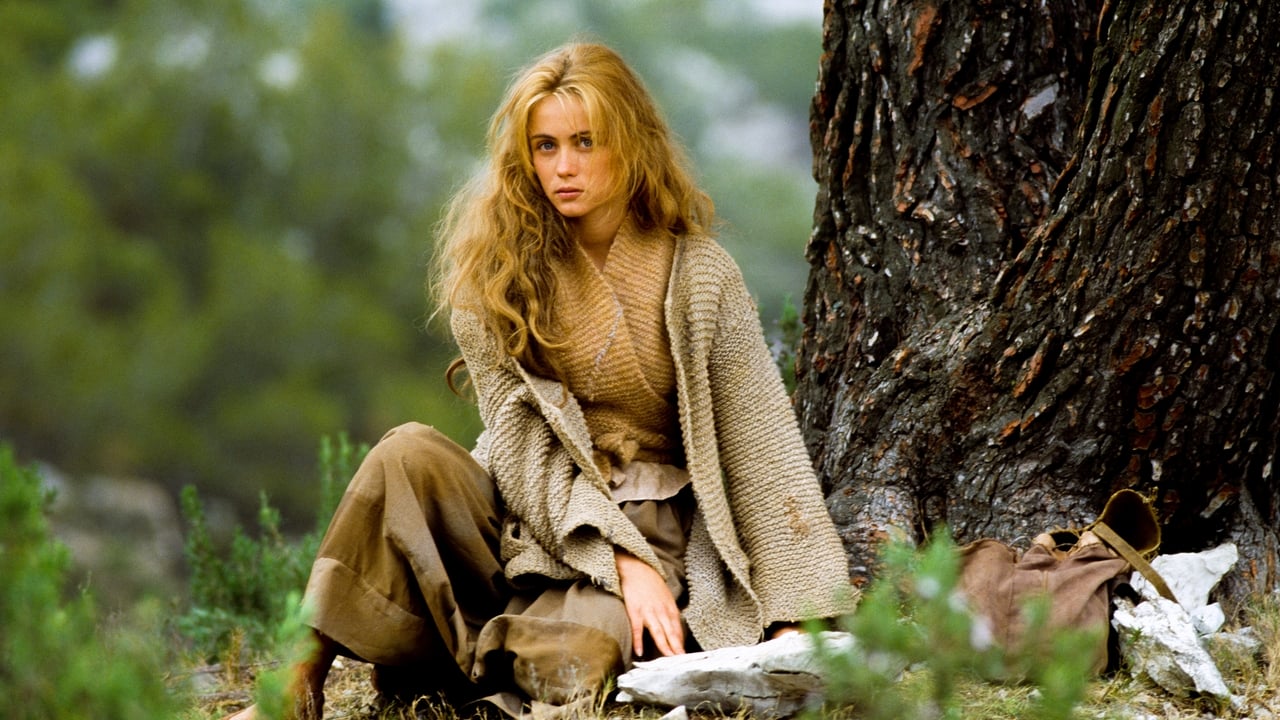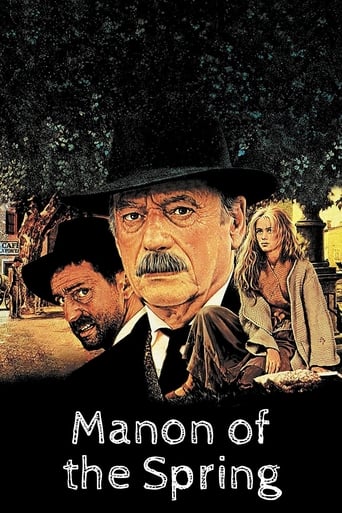Laikals
The greatest movie ever made..!
Keeley Coleman
The thing I enjoyed most about the film is the fact that it doesn't shy away from being a super-sized-cliche;
Mandeep Tyson
The acting in this movie is really good.
Skyler
Great movie. Not sure what people expected but I found it highly entertaining.
Tweekums
Set approximately ten years after the events in 'Jean de Florette' we return to the same sale area of Provence. Jean's daughter, Manon, is now a beautiful young woman tending goats in the rugged hills near where her father attempted to farm. Meanwhile life is good for César Soubeyran and his nephew Ugolin, the men who cheated Manon and her mother out of their home and whose actions lead to the death of her father. Ugolin has developed feelings for Manon; he spies on her and puts hares and thrushes in her traps... she seems keener on the new school teacher though. Then she overhears two hunters talking about what happened ten years previously; in particular how César and Ugolin had blocked the spring. It isn't long before she seeks her revenge.I really enjoyed 'Jean de Florette'; so much so that I watched this 'part two' within a week. I was pleased to find that this is at least as good as the first film... in fact I think I marginally preferred this one. No time is wasted explaining what happened in the first film so I would say that it is essential that you watch 'Jean de Florette' first. The story provides plenty of laughs as well as moments so tragic that one can't help feeling sorry for antagonists César and Ugolin. Emmanuelle Béart is a delight as Manon; making her seem simultaneously vulnerable and as tough as the goats she tends. Yves Montand and Daniel Auteuil are equally impressive as César and Ugolin. As one might expect there is another delightful recreation of inter-war France and lots of beautiful scenery that is great to look out but would be hard to work. Overall I'd say that if you enjoyed 'Jean de Florette' this is a must see; if you've yet to see that watch it before watching this.
Luigi Di Pilla
This part two sticks dramatically to the first one. The wonderful girl Emmanuelle Béart delivered an interesting performance. Yves Montand did a great job here showing all the repertoire of this psychological character profile. He was really a great actor, chapeau. But Daniel Auteuil was also very credibly in this role until the end. Bravo. Finally, Claude Berri directed again like a master. Thank you for these two very nice films. Don't expect a fast paced story because it has a slow but surprising countdown. For all that likes the surroundings South of France this is a rich experience to not miss. See also the other highlight La Fille du Pusatier from the same writer Marcel Pagnol. Vote: 8/10.
Sindre Kaspersen
French actor, producer, screenwriter and director Claude Berri's thirteenth feature film which he co-wrote with French screenwriter Gèrard Brach (1927-2006) is an adaptation of a novel, "L'Eau des Collines - Jean de Florette and Manon des Sources" (1964) by French author, playwright and filmmaker Marcel Pagnol (1895-1974), which was inspired by true events. It was shot on numerous locations in the Vaucluse department of Provence in the southeast of France and is part of a duo logy which was preceded by "Jean De Florette" (1986). It tells the story about Manon Cadoret who still lives in the highlands of Provence ten years after her and her mother Aimeé had to sell their property to Cesar Le Papet Soubeyran and his nephew Ugolin Soubeyran. Manon has become a shepherd girl and lives a quiet life, but when she one summer day encounters Ugolin who now is a successful farmer, bad memories are awakened. Struck by the now grown up Manon who he has not seen since she was a little girl, Ugolin falls head over heels in love with her. But Manon still remembers what he and his uncle did to her family, and she has found a way to reveal their secret.Like the first part of this epic story, this continuation is subtly and acutely directed by French filmmaker Claude Berri (1934-2009) and with it's ardent milieu depictions and efficient narrative structure, it draws an incessantly engaging portrayal of a young French woman who has been waiting several years to get justice for what happened to her family a decade earlier in time. This reverent sequel from the mid-1980s, produced by French producers Pierre Grunstein and Alain Poiré (1917-2000), is a co-production between France, Italy and Switzerland and has a powerful score by French composer Jean-Claude Petit, based on Italian composer Giuseppe Verdi's Italian opera "The Force of Destiny" (1862), which reinforces the film's atmosphere.Notable for it's wonderful production design by production designer Bernard Vézat and cinematography by French director and cinematographer Bruno Nuytten which is as present here as in the first segment, this historical period drama becomes an in-depth study of character that examines themes such as family relations, faith, morality and love, and is impelled by Yves Montand, Emmanuelle Béart and Daniel Auteuil's compassionate acting performances. A memorable, moving and humane film which gained, among other awards, the César Award for best supporting actress Emmanuelle Béart at the 13th César Awards in 1987 and the KCFCC Award for Best Foreign Language Film at the Kansas City Film Critics Circle Awards in 1988.
zjerunk
I have many favorites, and this is one of the crème de la crème. This is a visually stunning film more like beautiful photographic montage. It is simple, tragic story well told, unlike many of today's plots - implausibly lame, suffering on a CGI crutch for 85 minutes. The simple story is about enduring truths which have been the mainstay of the Greek classics and Shakespeare: Our human strengths, our failings, our virtues, and our vices. The story may be a fiction, but its kernel is not. It is stories and story telling like this which has kept our rapt attention for four thousand years.First we should understand that this film is NOT A SEQUEL, but the second half the novel by Marcel Pagnol which would have been too long as a single film, and out of necessity, was shot as two. The first half is titled, Jean de Florette. Neither film stands alone as satisfactory because, obviously, it would be incomplete, and naturally, is also important that the two halves be viewed in sequence. For a fairly dispassionate précis of the plots, I suggest reading the ones on Wikipedia and the discussion boards, so I won't be repetitive here. JdF & MotS were both shot at the same time in 1986 with a budget of $17 million making it/them the biggest budget French films up to that time. JdF grossed $86M worldwide, and of that sum, only $4.9M was from the USA. MotS grossed $56M worldwide, of which only $3.9M was from the USA. In other words, culture films are not a good fit for the American viewing audience, and the gross revenue numbers bear this out. The rest of the world seems to bear out this conclusion.Foreign language films rarely do well in the USA for the simple reason that the vast majority of the viewing audience are unilingual anglophones who do not wish to burden themselves with having to work at "understanding" their entertainment - they wish to merely consume it. If it requires the work of reading subtitles or thought, it becomes unpalatable. This film requires your attention and thought!But to be fair to the US viewers, the subtitles are at times incomplete or inaccurate, and unlike the spoken word, they do not convey the emphasis or importance of certain bits of dialogue well. The plot is woven steadily throughout the film, so the viewers with no understanding at all of the French language are missing essential dialogue, and therefore plot.The bottom line is this: You will either be entranced by these two films and love them, or you will be bored by the first 15 minutes, and you'll translate that into "bad film." If your highest quality level of reading is Marvel comics then I suggest you stay away from this one.However, I recall years ago walking into a video store where this was playing on all the monitors. All the patrons in the store, ranging in age from 5 to 75 years, were standing transfixed watching this film. There was something magical about it!

